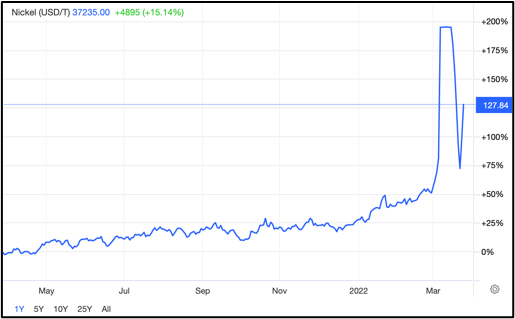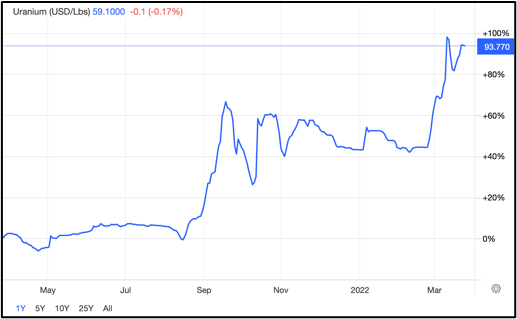The Short Squeeze and Uranium Tailwinds
Previously, we discussed the divergence of commodities from other markets but also the differences within commodities. Diving deeper, we discuss the effects of recent events on uranium and nickel, highlighted by the charts below.
The nickel spot price had steadily been gaining strength over the last couple of years as an important battery metal on the back of increasing demand for EV’s and supply shortage due to the pandemic. However, since the Ukraine crisis in March, nickel has gone parabolic underpinned by not only supply concerns out of Russia (third largest supplier at ~11%) but also mainly due to a so-called short squeeze causing the London Metal Exchange (LME) to freeze trading for over a week. The surge was driven by Tsingshan Holding Group Co (a top nickel producer) who had placed a large wager (~$3B short) that the nickel spot price would fall. The opposite occurred when Russia invaded Ukraine and nickel purchasers boycotted Russian nickel causing the supply to tighten further thereby increasing the spot price. This increase led to Tsingshan having to cover their short position by purchasing nickel at higher spot prices leading to an unprecedented surge in price and recent volatility. Nickel has started trading again; however, the LME canceled billions of dollars’ worth of transactions as the market tried to mitigate further price increase and volatility. We expect to see continued volatility as a significant short position remains.

The uranium spot price, although not as volatile as nickel, has also seen significant tailwinds as countries push for cleaner energy to curb greenhouse gas emissions. This has led to larger funds such as Sprott Asset Management to purchase excess supply based on future demand expectations. Demand has been further magnified upon the invasion of Ukraine pushing uranium spot prices to 10-year highs. Russia is the largest supplier of refined/enriched uranium at ~42% (7% mined production) and although no official sanctions on Russian uranium have been imposed, speculation continues to drive prices higher (up 30% since the invasion).

“This means that” recent events will be short lived-in terms of surging spot pricing; however, the long-term effects may take the form of countries increasing domestic production of natural resource and diversifying sources for commodities. This bodes well for a sustained rally in commodity prices going forward as demand remains strong based on fundamental supply issues.
National Instrument 31-103 requires registered firms to disclose information that a reasonable investor would expect to know, including any material conflicts with the firm or its representatives. Doug Johnson and/or Pathfinder Asset Management Limited are an insider of companies periodically mentioned in this report. Please visit www.paml.ca for full disclosures.
*All returns are time weighted and net of investment management fees. Returns from the Pathfinder Partners’ Fund and Partners’ Real Return Plus Fund are presented based on the masters series of each fund. The Pathfinder Core: Equity Portfolio and The Pathfinder Core: High Income Portfolio are live accounts. These are actual accounts owned by the Pathfinder Chairman (Equity) and client (High Income) which contain no legacy positions, cash flows or other Pathfinder investment mandates or products. Monthly inception dates for each fund and portfolio are as follows: Pathfinder Core: Equity Portfolio (January 2011), Pathfinder Core: High Income Portfolio (October 2012) Partners’ Fund (April 2011), Partners’ Real Return Plus Fund (April, 2013), and Partners’ Core Plus Fund (November 2014).
Pathfinder Asset Management Limited (PAML) and its affiliates may collectively beneficially own in excess of 10% of one or more classes of the issued and outstanding equity securities mentioned in this newsletter. This publication is intended only to convey information. It is not to be construed as an investment guide or as an offer or solicitation of an offer to buy or sell any of the securities mentioned in it. The author has taken all usual and reasonable precautions to determine that the information contained in this publication has been obtained from sources believed to be reliable and that the procedures used to summarize and analyze such information are based on approved practices and principles in the investment industry. However, the market forces underlying investment value are subject to sudden and dramatic changes and data availability varies from one moment to the next. Consequently, neither the author nor PAML can make any warranty as to the accuracy or completeness of information, analysis or views contained in this publication or their usefulness or suitability in any particular circumstance. You should not undertake any investment or portfolio assessment or other transaction on the basis of this publication, but should first consult your portfolio manager, who can assess all relevant particulars of any proposed investment or transaction. PAML and the author accept no liability of any kind whatsoever or any damages or losses incurred by you as a result of reliance upon or use of this publication.